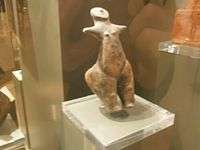Körös culture
| Period | Neolithic Europe |
|---|---|
| Dates | circa 5,800 B.C.E. — circa 5,300 B.C.E. |
| Preceded by | Mesolithic Europe |

Neolithic Venus figurine with steatopygia, produced by the Körös/Criş culture. Found in Méhtelek, Hungary
The Körös culture/Criş culture is a Neolithic archaeological culture in Central Europe that was named after the river Körös in eastern Hungary. The same river has the name Criș in Romania, hence the name Criş culture. The 2 variants of the river name are used for the same archaeological culture in the 2 regions. The Criș culture survived from about 5800 to 5300 BC. It is related to the neighboring Starčevo culture and is included within a larger grouping known as the Starčevo–Körös–Criş culture.[1]
See also
References
- ↑ Trbuhović 2006, p. 62.
Sources
- Trbuhović, V. (2006). Indoevropljani [Indo-Europeans]. Belgrade: Pešić i sinovi.
External links
| Wikimedia Commons has media related to Starčevo culture. |
This article is issued from
Wikipedia.
The text is licensed under Creative Commons - Attribution - Sharealike.
Additional terms may apply for the media files.